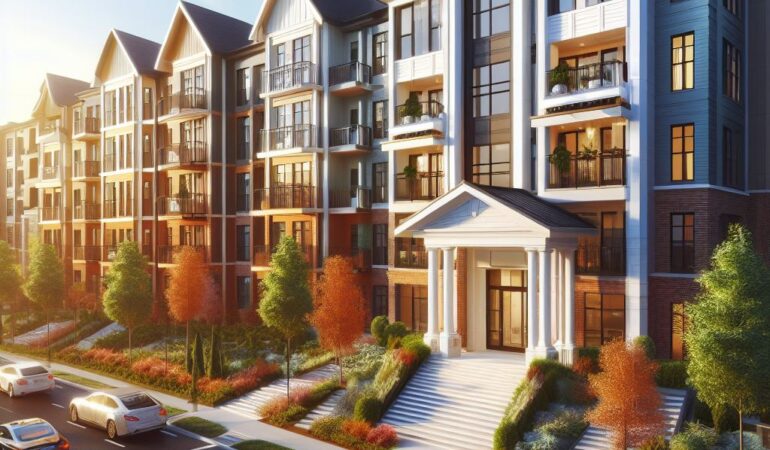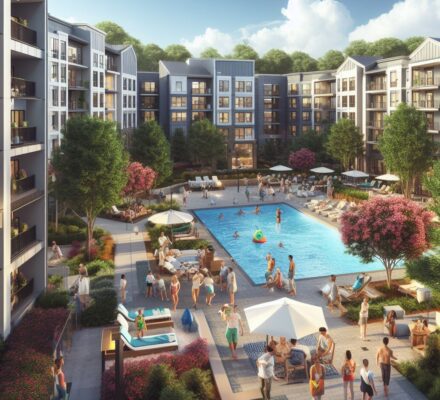Did you know that renovating multifamily properties can significantly increase their investment potential?
In fact, studies show that properly executed renovations can result in higher rental rates and increased property value.
If you’re looking to elevate your multifamily investments, this article will guide you through the process of:
- Assessing the investment potential
- Identifying renovation opportunities
- Budgeting and financing renovations
- Managing the renovation process
- Maximizing returns
Get ready to transform your multifamily properties into profitable assets through strategic renovations.
Key Takeaways
- Conduct a thorough analysis of the property’s current condition and market demand to assess its investment potential.
- Identify renovation opportunities by analyzing the property’s current state and understanding market trends.
- Develop a detailed budget and explore financing options to fund the renovations.
- Manage the renovation process by creating a project plan, tracking progress, and regularly communicating updates to stakeholders.
Assessing the Investment Potential
Assess the investment potential of your multifamily property by conducting a thorough analysis of its current condition and market demand. To accurately determine the potential return on investment (ROI), it’s crucial to examine various factors that influence the property’s value.
Firstly, assess the current condition of the property. Consider its age, structural integrity, and overall maintenance. A property in good condition may require minimal renovations, resulting in lower costs and a quicker turnaround time for achieving profitability. On the other hand, a property in poor condition may require extensive renovations, increasing costs and prolonging the investment timeline.
Next, examine the market demand in the area. Evaluate the rental rates, vacancy rates, and the overall growth of the rental market. A high demand for rental properties indicates a greater potential for generating substantial rental income. Additionally, consider the location’s proximity to amenities such as schools, shopping centers, and transportation hubs. These factors can significantly impact the property’s attractiveness to potential tenants.
Furthermore, analyze the potential for future appreciation. Research the historical trends in property values in the area and identify any upcoming developments or infrastructure projects that could positively impact the property’s value over time.
Identifying Renovation Opportunities
To identify renovation opportunities for your multifamily property, consider the specific areas and aspects that can be improved to enhance its overall value and appeal. By analyzing the current state of your property and understanding market trends, you can identify areas that require upgrades or improvements to attract tenants and increase rental income.
A helpful way to organize your analysis is by using a table to visually represent the potential renovation opportunities. Here is an example of a table that can guide your decision-making process:
| Area/Aspect | Potential Renovation Opportunities | Benefits |
|---|---|---|
| Exterior | Repaint the building | Improved curb appeal |
| Upgrade landscaping | Enhanced aesthetic appeal | |
| Install new signage | Increased visibility | |
| Add outdoor amenities | Attraction for tenants | |
| Interior | Upgrade kitchen appliances | Higher rent potential |
| Replace flooring | Modern and clean appearance | |
| Update bathroom fixtures | Improved functionality | |
| Install energy-efficient lighting | Cost savings for tenants | |
| Common Areas | Refresh paint and decor | Welcoming and inviting |
| Update furniture and fixtures | Enhanced tenant experience | |
| Add fitness center or communal space | Increased tenant satisfaction |
Budgeting and Financing Renovations
How can you effectively budget and finance renovations for your multifamily property?
Renovations can be a significant investment, but with careful planning and financing, you can maximize the return on your investment and elevate the value of your property.
First, it’s crucial to assess the scope of the renovations and create a detailed budget. Take into account all the necessary materials, labor costs, and any additional expenses such as permits or inspections. Conducting a thorough cost analysis will help you avoid surprises and ensure that you have enough funds allocated for the project.
When it comes to financing, there are several options to consider. Traditional lenders, such as banks or credit unions, offer mortgage loans that can be used for renovations. However, these loans often come with strict requirements and lengthy approval processes. Alternatively, you can explore private financing options, such as hard money loans or crowdfunding platforms, which can provide faster access to funds with fewer stringent qualifications.
Another financing strategy is to leverage the value of your property through a cash-out refinance. This involves refinancing your existing mortgage for a higher amount than you currently owe and using the difference to fund your renovations. Keep in mind that this option may increase your overall debt and require careful financial planning.
Lastly, consider partnering with investors who are willing to provide the necessary funds in exchange for a share of the profits. This can be an effective way to finance renovations while sharing the risks and rewards with others.
Managing the Renovation Process
Now that you have carefully budgeted and secured financing for your multifamily property renovations, it’s time to take charge and effectively manage the renovation process. A well-managed renovation can’t only enhance the value of your property but also attract desirable tenants and maximize returns.
Here are three key strategies to help you successfully manage the renovation process:
- Develop a detailed project plan: Outline the scope of work, establish a timeline, and identify key milestones. This will help you stay organized and ensure that the renovation stays on track. Use project management software to track progress and communicate with contractors and suppliers.
- Regularly communicate with stakeholders: Keep all parties involved, including contractors, property managers, and tenants, informed about the renovation process. Regularly communicate updates, address any concerns, and ensure that everyone is on the same page. This will help maintain transparency and minimize disruptions.
- Monitor costs and quality: Keep a close eye on the renovation budget and monitor expenses throughout the process. Regularly review invoices and compare them to the budget to identify any discrepancies. Additionally, regularly inspect the quality of work to ensure that it meets your standards and expectations.
By effectively managing the renovation process, you can minimize risks, control costs, and maximize returns on your multifamily property.
Now, let’s explore how you can further enhance your investment by maximizing returns on multifamily renovations.
Maximizing Returns on Multifamily Renovations
By implementing strategic renovation strategies, you can maximize your multifamily property’s returns. Renovations are a key component of increasing the value and attractiveness of your property, ultimately leading to higher rental income and potential capital appreciation. To help you make informed decisions and prioritize renovations that will yield the highest returns, consider the following factors:
- Market Demand: Analyze the local rental market to identify the most desirable features and amenities that attract tenants. Focus on renovations that align with market demand to increase your property’s appeal and rental rates.
- Cost vs. Benefit Analysis: Conduct a detailed cost vs. benefit analysis for each potential renovation project. Evaluate the estimated costs, expected increase in rental income, and potential appreciation in property value to determine the projects that offer the highest return on investment.
- Tenant Retention: Prioritize renovations that improve tenant satisfaction and retention. Enhancing common areas, upgrading amenities, and providing modern finishes can attract and retain high-quality tenants, reducing vacancies and turnover costs.
Consider the table below to further understand the potential returns on investment for different renovation projects:
| Renovation Project | Estimated Cost | Expected Increase in Rental Income | Potential Appreciation |
|---|---|---|---|
| Kitchen Remodel | $15,000 | $200/month | 5% |
| Bathroom Upgrade | $8,000 | $100/month | 3% |
| Flooring Update | $5,000 | $75/month | 2% |
| Exterior Painting | $10,000 | $150/month | 4% |
| Energy Efficiency | $7,500 | $80/month | 2.5% |
Frequently Asked Questions
What Are the Potential Risks Associated With Multifamily Renovations and How Can They Be Mitigated?
Potential risks associated with multifamily renovations include cost overruns, delays, and tenant dissatisfaction. To mitigate these risks, carefully plan and budget for the project, conduct thorough due diligence, hire experienced contractors, and communicate transparently with tenants throughout the process.
Are There Any Specific Regulations or Permits That Need to Be Obtained Before Starting a Renovation Project on a Multifamily Property?
Before starting a renovation project on a multifamily property, it’s important to consider the specific regulations or permits that need to be obtained. Failure to comply can lead to delays, fines, and legal issues.
How Can Property Owners Ensure That Renovations Are Completed on Time and Within Budget?
To ensure renovations are completed on time and within budget, start by creating a detailed project plan with specific timelines and cost estimates. Regularly monitor progress, address any issues promptly, and maintain open communication with contractors and suppliers.
What Are Some Effective Strategies for Marketing and Attracting New Tenants After Completing a Multifamily Renovation Project?
To attract new tenants after a multifamily renovation, market the property with high-quality photos, virtual tours, and engaging descriptions. Utilize online platforms, social media, and targeted advertising to reach your target audience.
Are There Any Tax Incentives or Financial Benefits Available for Multifamily Property Owners Who Undertake Renovations?
There are indeed tax incentives and financial benefits available for multifamily property owners who undertake renovations. These incentives can include tax deductions, credits, and grants, which can significantly reduce the financial burden of the renovation project.




